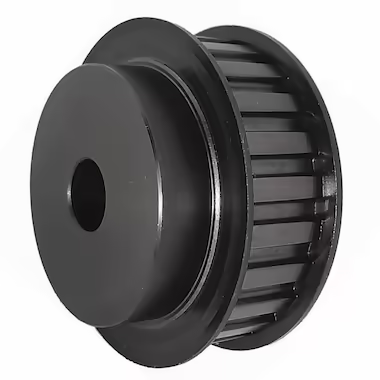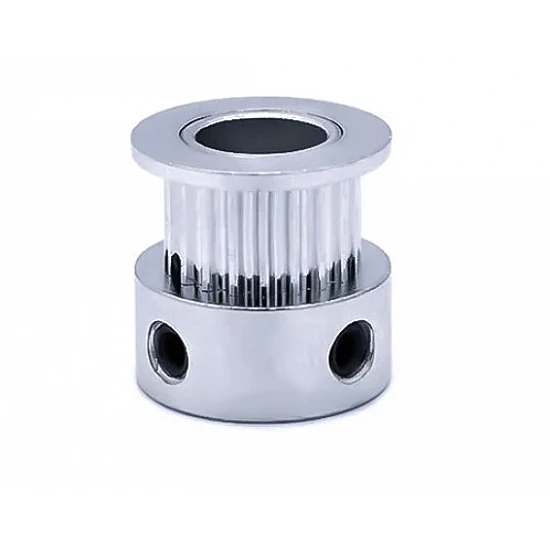Product Description
HTD3M 2GT T10 S2M MXL XL Transmission Part Timing Belt Pulleys For CNC Machine
Advantages:
1. Good quality products
2. Competitive prices
3. Fast delivery
4. Best after-sale service
5. Brand: HeFa or OEM/ ODM
6.Normal torque drive timing pulley:MXL/XL/L/H
7.High torque drive gear type: S2M/ S3M/ S5M/ S8M/ HTD3M /HTD5M/ HTD8M/P2M/P3M/P5M/P8M
8.High precision position drive gear type:2GT/3GT/5GT/8YU
9.Light load drive gear type:T5/T10
10.Heavy load drive gear type:AT5/AT10
11.High temperature resistance,Self lubrication,Wear resistance,Flame retardant properties
Product Parameters
| Product | Timing Belt Pulley & idler pulley |
| Teeth type | Normal Torque Drive Type:MXL,XL,L,H,XH,XXH High Torque Drive Type:S2M,S3M,S5M,S8M,HTD2M,HTD3M,HTD5M,HTD8M,P2M,P3M,P5M,P8M High Precision Position Drive Type:2GT,3GT,5GT,8YU Light Load Drive Type:T5,T10,T20 Heavy Load Drive Type:AT5,AT10,AT20 |
| Basic shape | Type A,Type B,Type D,Type E,Type F,Type K |
| surface treatment | Natural color anodizing,Black anodizing,Hard anodizing,Ni-plating,Blackening |
| Material | 6061(aluminum),S45C(45# steel),SUS304(Stainless steel) |
| Bore | Pilot bore, Taper bore and Customized bore. |
| testing equipment | projecting apparatus,salt spray test,durometer,and coating thickness tester,2D projector |
| producing equipment | CNC machine,automatic lathe machine,stamping machine,CNC milling machine,rolling machine,lasering,tag grinding machine etc. |
| Machining Process | Gear Hobbing, Gear Milling, Gear Shaping, Gear Broaching,Gear Shaving, Gear Grinding and Gear Lapping |
| Application industry | Robot industry,Medical industry,Making machine industry,Automation industry,3C industry equipment,Packaging industry,UAV industry,New energy industry. |
| Advantages | 1.High temperature resistance,Self lubrication,Wear resistance,Flame retardant properties 2.Good quality products 3.Competitive prices 4.Fast delivery 5.Best after-sale service 6.Brand: HeFa or OEM/ ODM 7.Good service:satisfactory service before and after sale. 8.Direct manufacturers |
Company Profile
Packaging & Shipping
FAQ
| Main Markets? | North America, South America, Eastern Europe , West Europe , North Europe, South Europe, Asia |
| How to order? | * You send us drawing or sample |
| * We carry through project assessment | |
| * We give you our design for your confirmation | |
| * We make the sample and send it to you after you confirmed our design | |
| * You confirm the sample then place an order and pay us 30% deposit | |
| * We start producing | |
| * When the goods is done, you pay us the balance after you confirmed pictures or tracking numbers. | |
| * Trade is done, thank you!! |
| Certification: | CE, ISO |
|---|---|
| Pulley Sizes: | Type B |
| Manufacturing Process: | Casting |
| Material: | Stainless Steel |
| Surface Treatment: | Polishing |
| Application: | Chemical Industry, Grain Transport, Mining Transport, 3D Printer |
| Samples: |
US$ 10/Piece
1 Piece(Min.Order) | |
|---|
| Customization: |
Available
| Customized Request |
|---|

How do XL pulleys compare to other pulley types, such as HTD or V-belt pulleys?
XL pulleys, HTD pulleys, and V-belt pulleys are all popular types of pulleys used in mechanical systems. Here is a detailed comparison of XL pulleys with HTD and V-belt pulleys:
1. Tooth Profile:
XL pulleys and HTD (High Torque Drive) pulleys both utilize toothed belts for power transmission. The main difference lies in their tooth profiles. XL pulleys have trapezoidal teeth, while HTD pulleys have a curvilinear tooth profile. V-belt pulleys, on the other hand, are designed for V-belts, which have a wider, wedge-shaped cross-section.
2. Power Transmission Capacity:
XL pulleys and HTD pulleys offer higher power transmission capacities compared to V-belt pulleys. The toothed belt designs of XL and HTD pulleys provide a positive engagement, preventing slippage under higher loads or torque. V-belt pulleys rely on friction between the belt and pulley, limiting their power transmission capacity.
3. Speed Capability:
XL pulleys and HTD pulleys are both suitable for higher speed applications compared to V-belt pulleys. The toothed belt designs allow for better grip and reduced belt slippage, enabling XL and HTD pulleys to operate at higher rotational speeds without compromising performance. V-belt pulleys are generally suitable for lower speed applications.
4. Efficiency:
XL pulleys and HTD pulleys offer higher efficiency compared to V-belt pulleys. The positive engagement between the toothed belts and pulleys in XL and HTD systems minimizes slippage and associated energy losses. V-belt pulleys, relying on friction, may experience higher energy losses due to belt slip.
5. Precision and Positioning:
XL pulleys and HTD pulleys provide better positional accuracy and reduced backlash compared to V-belt pulleys. The toothed belt systems offer improved control and synchronization, making them suitable for applications that require precise positioning or timing, such as robotics or CNC machines.
6. Noise and Vibration:
XL pulleys and HTD pulleys generally produce less noise and vibration compared to V-belt pulleys. The toothed belt systems exhibit smoother operation due to their positive engagement, reducing noise and vibration levels. V-belt pulleys may generate more noise and vibration due to potential slippage and belt oscillation.
7. Installation and Maintenance:
XL pulleys, HTD pulleys, and V-belt pulleys are all relatively easy to install and maintain. However, V-belt pulleys may require more frequent tension adjustments and periodic belt replacements due to belt wear and stretch. Toothed belt systems, including XL and HTD pulleys, often require less maintenance and offer longer belt life.
8. Application Suitability:
The choice between XL pulleys, HTD pulleys, and V-belt pulleys depends on the specific application requirements. XL and HTD pulleys are commonly used in industrial automation, power transmission, and precision machinery applications that demand higher torque, speed, and accuracy. V-belt pulleys are often employed in applications such as HVAC systems, automotive engines, and smaller machinery.
In summary, XL pulleys, HTD pulleys, and V-belt pulleys have differences in tooth profile, power transmission capacity, speed capability, efficiency, precision, noise/vibration levels, installation/maintenance, and application suitability. Understanding these differences is crucial in selecting the most appropriate pulley type for a given mechanical system and its specific requirements.

How does the tooth profile of XL pulleys contribute to their performance?
The tooth profile of XL pulleys plays a crucial role in determining their performance in power transmission systems. Here’s a detailed explanation of how the tooth profile contributes to their performance:
1. Efficient Power Transmission:
The tooth profile of XL pulleys is designed to engage with the corresponding teeth on the timing belt. This positive engagement ensures efficient power transmission by minimizing slippage and maximizing the transfer of rotational motion. The tooth profile allows for a large contact area between the pulley and the belt, enabling effective torque transfer and minimizing energy losses.
2. Accurate and Repeatable Positioning:
The tooth profile of XL pulleys enables accurate and repeatable positioning in motion control systems. The teeth on the pulley mesh precisely with the teeth on the timing belt, providing precise angular displacement and positioning control. This tooth engagement allows for reliable and consistent positioning, making XL pulleys suitable for applications that require high positional accuracy, such as robotics and CNC machines.
3. Reduced Backlash:
The tooth profile of XL pulleys helps reduce backlash, which is the play or clearance between the teeth of the pulley and the belt. Backlash can introduce inaccuracies and vibrations in the power transmission system. The tooth profile of XL pulleys minimizes backlash by ensuring a close fit with the timing belt teeth, resulting in smoother operation, improved precision, and reduced mechanical vibrations.
4. Load Distribution:
The tooth profile of XL pulleys allows for effective load distribution along the width of the belt. As torque is transmitted from the pulley to the belt, the tooth profile ensures that the load is evenly distributed across the belt’s width. This load distribution helps prevent concentrated stress points and excessive wear on specific areas, leading to improved durability and longevity of the pulley and belt.
5. Noise Reduction:
XL pulleys with well-designed tooth profiles contribute to reduced noise levels during operation. The tooth engagement and smooth meshing between the pulley and the timing belt minimize vibration and noise generation. This advantage is particularly important in applications that require low noise levels, such as medical equipment, office machinery, and audiovisual systems.
Overall, the tooth profile of XL pulleys significantly impacts their performance by enabling efficient power transmission, precise positioning, reduced backlash, even load distribution, and noise reduction. Manufacturers carefully design the tooth profiles of XL pulleys to optimize these performance characteristics for various applications and operating conditions.

Are XL pulleys available in different sizes and configurations?
Yes, XL pulleys are available in a variety of sizes and configurations to accommodate different application requirements. The size and configuration of XL pulleys can vary in terms of the number of teeth, pitch diameter, bore size, and overall dimensions. Here are some key aspects of the size and configuration options for XL pulleys:
1. Number of Teeth:
XL pulleys are manufactured with a specific number of teeth that correspond to the tooth profile of the timing belt they are designed to work with. The number of teeth affects the speed ratio, torque transmission, and positioning resolution of the pulley system. XL pulleys can have different tooth counts to meet the specific motion control requirements of the application.
2. Pitch Diameter:
The pitch diameter of an XL pulley refers to the diameter of the circle formed by the centerline of the pulley’s teeth. XL pulleys are available with different pitch diameters to accommodate various belt lengths and speed requirements. The pitch diameter affects the linear velocity and torque transfer capabilities of the pulley system.
3. Bore Size:
The bore size of an XL pulley refers to the diameter of the central hole through which the pulley is mounted onto a shaft. XL pulleys are designed with different bore sizes to fit various shaft diameters. They can have standard bores or keyway/keyslot configurations to ensure secure and precise shaft coupling.
4. Overall Dimensions:
XL pulleys come in different overall dimensions, which include the outer diameter, hub width, and flange size. The outer diameter determines the pulley’s physical size, while the hub width and flange size affect the pulley’s stability and belt retention. These dimensions are chosen based on the specific application requirements and available space constraints.
5. Customization:
While standard sizes and configurations of XL pulleys are readily available, manufacturers often offer customization options to meet unique application needs. Customization can involve specific tooth profiles, special bore sizes, non-standard dimensions, or even the use of different materials to suit specific operating conditions.
When selecting XL pulleys, it is essential to consider the requirements of the application, including the desired motion control parameters, load capacity, and space limitations. Consulting with pulley manufacturers or suppliers can help ensure the selection of the most appropriate size and configuration for the specific application.


editor by CX
2023-09-28